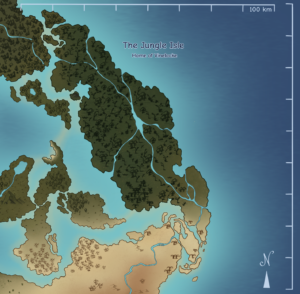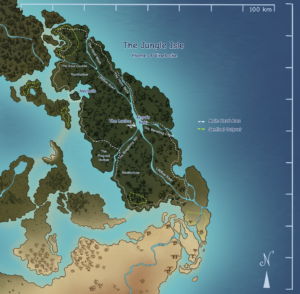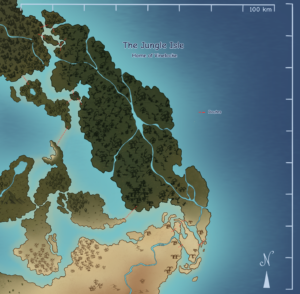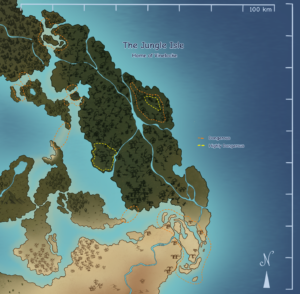Herd Location – The Jungle Isle
Click image for larger view!
Located to the far east of the Archipelago, the thickly jungled isle is a large, single island without too much variation in geography. There are some higher climbs and some small mountains that boast spectacular cloud forests, but the vast majority of the island remains at around the same elevation. There are some smaller islets bordering it to the west, one of which holds a stony mountain surrounded by dense, bioluminescent foliage. With a climate similar to the Amazon, it is hot and humid year round, with seasonal heavy rainfall and dryer spells towards Frosthold and Sunhigh, respectively. Scattered throughout the island are numerous small bioluminescent hubs. Each of these are considered sacred sites. The two largest hubs are the herd capitol and religious capitol, and these are guarded and revered closely by all tribes.
Important Locations
Click image for larger view!
Main Herd Area
The whole of Vinelocke occupies much of the Jungle Isle. The herd used to be divided into tribal territories, but now the land is shared equally by all five tribes.
Roothollow
Roothollow is the name of the jungle spreading the expanse of the Island. It is thick and dense, especially around the center near Kiora’s rest. The Delvers have made many paths through Roothollow, and it is wise to stay on the marked roads.
Nectaris
Nectaris is one of the largest bioluminescent sites on the islands. It is situated in the center of an ancient volcanic crater whose fertile soil has the richest and most beautiful bioluminescent hub on the Jungle Isle. This site was established centuries ago as the religious capital for Vinelocke, as many ancient shamans had encounters with the gods here. Today, not much has changed. If a phae wishes to have a spiritual encounter, this is the place to come.
The Lucine
Lucine is the capital city of Vinelocke, situated in the heart of the jungle along the shore of Kiora’s Rest. The Lucine is the second largest bioluminescent site on the island. At the center of the city lies two ancient standing stones, both carved in the likeness of the two moons circling Thaeria. These stones are carved with indiscernible ancient runes that glow ominously when the moons are full or during an eclipse.
Kiora’s Rest
Kiora’s Rest is the spring fed lake at the center of the island. It rises from a natural spring at the heart of the island and feeds freshwater into the many branches of the Lifeflow River. This lake is thus named because it is thought to be the ancient home of the deity Kiora. This lake’s shores are lined with bioluminescent algae, and often the whole of the lake glows a cool blue when the algae is in bloom.
Lifeflow River
The Lifeflow river is given its name because it flows northwest and southeast from Kiora’s rest, providing fresh water to the whole of Jungle Isle. It is said that the tribe of Life got their name from this river.
The Hoof Wash
The Hoof Wash is the northernmost branch of the Lifeflow river, named for the Hoof tribe.
The Horn Beck
The Horn Beck is another northern branch of the Lifeflow river, slightly south of the Hoof Wash. It was named after the Horn tribe.
The Soul Course
The Soul Course is the northwesternmost branch of the Lifeflow river. This branch was named for the Soul tribe and is the closest branch to the Nectaris.
The Bleeding Creek
The Bleeding Creek is the western branch of the Lifeflow river. This branch was named for the Blood tribe.
The Breathing Rill
The Breathing Rill is the southeasternmost branch of the Lifeflow river. This branch was named for the missing tribe of Breath, who sadly lost their lives centuries ago to Emnos.
The Plagued Hollow
The ancient home of the lost tribe of Breath, this hollow was poisoned during Emnos’ attack upon Vinelocke. It is believed that Cephi channeled Emnos’ plague into the hollow, thus protecting the rest of the land from Emnos’ decaying touch. Here, the land is nearly uninhabitable, as it is overgrown with fungi and moss, their toxic spores filling the air. Naught but poisonous insects call this place home, and few phae dare travel here. Deep in the Hollow are the ruins of Breath’s home, and many ancient tablets can be found here. Over the years, great care has been taken to not spread the fungi from this spot, and only the most experienced Vipers or others with poison magic dare enter it.
Bordering Herds
Vinelocke shares a border with Stonemire to the north, with whom they are largely on good terms with, and with Dawnspire to the south, who they don’t mind especially, but would prefer to do brief dealings with. They are especially distrusting of distant Mirroweld, and have been exchanging espionage and subterfuge with since the beginning of the Dark Age.
Routes to Other Herds
Click image for larger view!
The Jungle Isle is geographically close to both Dawnspire and Stonemire, and there are many small islands that can be traversed to cross to another island. These paths are best taken in steps, as they can become dangerous when the tide is high. At low tide, the sandbars can easily be walked between islands.
Dangerous Areas
Click image for larger view!
As long as phae stay on the main paths through Roothollow, they can pass relatively unscathed. Predators know to avoid the well-trodden paths due to the diligence of Blood’s watch. There are patches of jungle where the predators have congregated, especially jaguars and large anacondas. Another area to be wary of is the Plauged Hollow. This ancestral home of the extinct Breath tribe is riddled with poisonous fungi, plants, and insects. Toxic spores fill the air, and no animals call this hollow their home. These are perhaps the most hazardous places on the land.
Caiman frequently occupy the shallow parts of rivers, though they can be avoided if one is watchful. Narrow, shallow areas on the rivers should be approached with caution. Other areas of the rivers are inhabited by piranhas, so swimming isn’t always recommended.
Crossing any body of water can be dangerous if the tide is high. Currents between the islands have been known to sweep away more than one phae who chose to cross on foot at the wrong time. Boats are always the safest option when traveling between the isles, but they can also be crossed cautiously at low-tide.
Flora & Fauna
The jungle is filled to the brim with tropical plants, insects, birds, amphibians, and other flora and fauna, both benevolent and hostile. With jaguars, anacondas, harpy eagles, giant anteaters, maned wolves, and caimans, there is no shortage of danger. That also says nothing of the dangerous plants and poisonous snakes and amphibians that inhabit the island as well. It can be lethal to the uninitiated, but thankfully, the locals are fairly adept at dealing with the threats of their homeland.
The flora and fauna of the jungle are nearly innumerable, and the climate is most akin to the Amazon rainforest. We have listed below many possible species, but for an extensive list, click this link.
Fruits, vegetables, and spices are available in many different species, many of which are used for trade with other islands or the creation of delicious treats, such as chocolate or sugar to sweeten food. Some of the fruits available in the jungle are cacao, papaya, breadfruit, starfruit, acai, camu camu, mango, coconuts, bananas, plantains, lemons, limes, and grapes. Some of the vegetables available are Yucca roots, mushrooms, cinnamon, corn, potatoes, rice, squash and yams. Some of the spices available are stevia, sacha inchi, guarana, aguaje, lemon grass, peppermint, spearmint, wild sage, vanilla, cloves, ginger, sugar cane, and turmeric. Other plants and trees growing across the jungle might include cotton, bromeliads, palms, epiphytes, vines, ferns, lilies, orchids, and innumerable tree species.
Other common predatory species found in the jungle include boa constrictors, black caiman, jaguars, anacondas, hawks, piranhas, and crab-eating racoons. Other fauna include tapir, toucans, sloths, macaws, frogs (poisonous or not), boto, monkeys, turtles, otters, woodpeckers, potoo, tilapia, osprey, peccary, ocelots, and capybara. Insects include many specimens of butterflies, ants, tarantulas, beetles, and honey bees.



